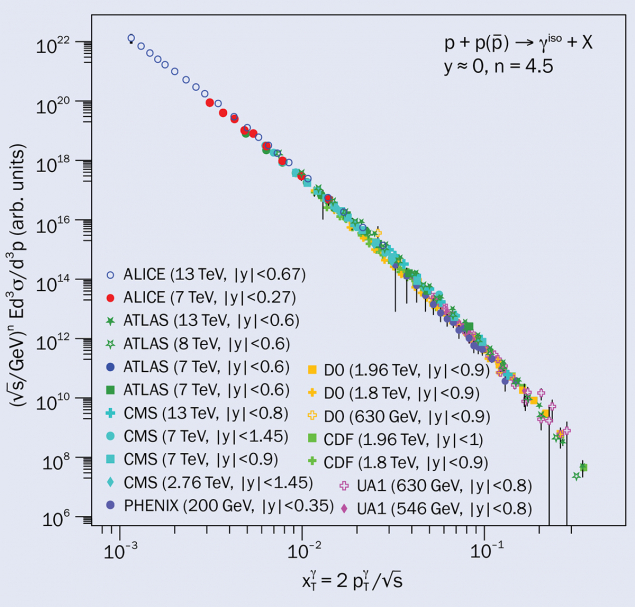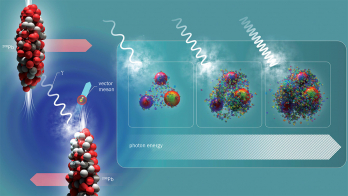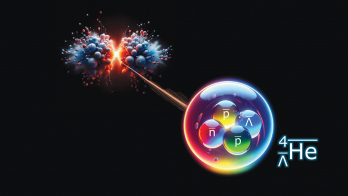
In high-energy collisions at the LHC, prompt photons are those that do not originate from particle decays and are instead directly produced by the hard scattering of quarks and gluons (partons). Due to their early production, they provide a clean method to probe the partons inside the colliding nucleons, and in particular the fraction of the momentum of the nucleon carried by each parton (Bjorken x). The distribution of each parton in Bjorken x is known as its parton distribution function (PDF).
Theoretical models of particle production rely on the precise knowledge of PDFs, which are derived from vast amounts of experimental data. The high centre-of-mass energies (√s) at the LHC probe very small values of the momentum fraction, Bjorken x. At “midrapidity”, when a parton scatters with a large angle with respect to the beam axis, and a prompt photon is produced in the final state, a useful approximation to Bjorken x is provided by the dimensionless variable xT = 2pT/√s, where pT is the transverse momentum of the prompt photon.
Prompt photons can also be produced by next-to-leading order processes such as parton fragmentation or bremsstrahlung. A clean separation of the different prompt photon sources is difficult experimentally, but fragmentation can be suppressed by selecting “isolated photons”. For a photon to be considered isolated, the sum of the transverse energies or transverse momenta of the particles produced in a cone around the photon must be smaller than some threshold – a selection that can be done both in the experimental measurement and theoretical calculations. An isolation requirement also helps to reduce the background of decay photons, since hadrons that can decay to photons are often produced in jet fragmentation.
The ALICE collaboration now reports the measurement of the differential cross-section for isolated photons in proton–proton collisions at √s = 13 TeV at midrapidity. The photon measurement is performed by the electromagnetic calorimeter, and the isolated photons are selected by combining with the data from the central inner tracking system and time-projection chamber, requiring that the summed pT of the charged particles in a cone of angular radius 0.4 radians centred on the photon candidate be smaller than 1.5 GeV/c. The isolated photon cross-sections are obtained within the transverse momentum range from 7 to 200 GeV/c, corresponding to 1.1 × 10–3 < xT < 30.8 × 10–3.
Figure 1 shows the new ALICE results alongside those from ATLAS, CMS and prior measurements in proton–proton and proton–antiproton collisions at lower values of √s. The figure spans more than 15 orders of magnitude on the y-axis, representing the cross-section, over a wide range of xT. The present measurement probes the smallest Bjorken x with isolated photons at midrapidity to date. The experimental data points show an agreement between all the measurements when scaled with the collision energy to the power n = 4.5. Such a scaling is designed to cancel the predicted 1/(pT)n dependence of partonic 2 → 2 scattering cross-sections in perturbative QCD and reveal insights into the gluon PDF (see “The other 99%“).
This measurement will help to constrain the gluon PDF and will play a crucial role in exploring medium-induced modifications of hard probes in nucleus–nucleus collisions.




